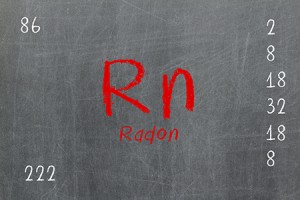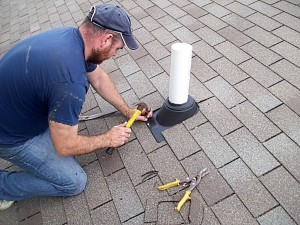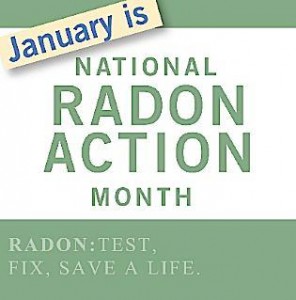 Welcome to National Radon Awareness month! All throughout the month we’ll be featuring news and information on Radon, and how you can protect your family from this silent killer. Don’t be alarmed if your local health department or third party companies announce the availability of free testing kits either. Testing for the presence of radon in your home is very important, and to ensure that many homeowners actually go through with it a lot of sources will give away testing kits at a discount — or free. National Radon Awareness month is a very important time, one that may people actually overlook.
Welcome to National Radon Awareness month! All throughout the month we’ll be featuring news and information on Radon, and how you can protect your family from this silent killer. Don’t be alarmed if your local health department or third party companies announce the availability of free testing kits either. Testing for the presence of radon in your home is very important, and to ensure that many homeowners actually go through with it a lot of sources will give away testing kits at a discount — or free. National Radon Awareness month is a very important time, one that may people actually overlook.
We’re going to kick off National Radon Awareness month — and the new year — with a comprehensive radon information guide. What does that mean exactly? Instead of featuring a relevant news story, or similar piece we’re going to outline all of the information we have available here at Radon Resources. In addition, we’ll point out alternate resources where you may find more informations, stats and data on Radon. After all, we claim quite often that radon is second leading cause of lung cancer, but it helps to have a proven source for such information, right?
Let’s get started!
National Radon Awareness Month: General Radon Information
Before you can take action, first you need to understand what exactly radon gas is, where it comes from and why it’s so dangerous. You’d be surprised how many people have never even heard of this silent killer. Worse yet, many people know that it’s an issue but blatantly ignore testing, and anything that goes along with it. There’s a common misconception that it used to be a problem years ago, and has since been solved.
Believe it or not, modern homes are designed with radon resistant construction in order to prevent radon gas from seeping inside, however this is no guarantee it can’t get into your home. Even if your home was built using these standards, there’s still a chance that the deadly gas can collect inside your home. When that happens — when it collects in great amounts — the air inside your home becomes hazardous to not only your health, but your family’s and anyone that visits you.
If you’d like to read some more general information about Radon gas, be sure to check out our guide on “What is Radon?” You can also head over the official US EPA page dedicated to Radon, which is where we acquired most of our information on the topic.
What is Radon Gas, Where Does it Come From and Why is it so Dangerous?
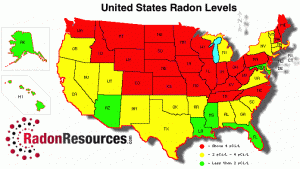 Radon is a radioactive gas that is produced as a natural byproduct of various elements undergoing radioactive decay. These elements — such as Uranium — can be commonly found in the soil and rock in the ground. As they undergo radioactive decay, they give off particles known as Radon daughters. These particles form one of the most dense gases known, that seeps up from the soil and into many areas surrounding it.
Radon is a radioactive gas that is produced as a natural byproduct of various elements undergoing radioactive decay. These elements — such as Uranium — can be commonly found in the soil and rock in the ground. As they undergo radioactive decay, they give off particles known as Radon daughters. These particles form one of the most dense gases known, that seeps up from the soil and into many areas surrounding it.
Radon is colorless, odorless and tasteless which means it’s virtually indetectable. In fact, the only way to discover it’s presence — or whether or not it’s a problem in your home — is to test specifically for it with a proprietary testing kit.
Since it can be produced by common elements, radon gas can be a problem anywhere. There are areas that are more prone to radon problems, obviously but this does not necessarily mean there are areas where radon does not exist. On the contrary, radon can be a problem anywhere.
Most people tend to believe that because their neighbor’s house was tested and is safe — or was found to contain dangerous levels — it’s indicative of their own home. This is not true at all. You could have two homes sitting side by side and one of them could turn up elevated levels while the other could be perfectly safe. That is why it is extremely important for you to test your own home, regardless of local results and patterns.
At this point you’re probably saying, well all this is great but why is it so dangerous? The answer to that question is pretty simple. Radon is the second leading cause of lung cancer in many countries including the US, UK, Canada and more. In the US alone, it is responsible for the deaths of more than 21,000 each year. It also happens to be the leading cause of lung cancer in non-smokers. It’s pretty dangerous stuff, because lung cancer has one of the highest mortality rates of any form of cancer. There are many reasons for this, one of which has to do with the time it takes to diagnose the disease. By the time most patients have begun to show symptoms and have been diagnosed, it has progressed well beyond a curable state. The most unfortunate part about that is it could be easily prevented in most cases. One simply needs to test their home for the presence of radon gas.
National Radon Awareness Month: Radon Testing
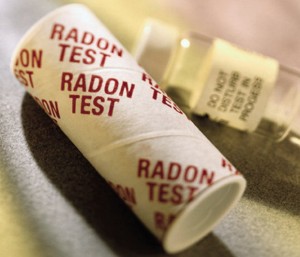 Radon testing is performed in a home, residence, or business to identify the average radon gas levels inside the structure. If elevated levels are discovered, that’s when it’s time to take action to lower the levels to a more healthy limit. In general, you often perform a short term test — or multiple — to find the levels in your home at that point in time. If elevated levels are discovered, then you generally perform a long term test to find the average levels, which are more accurate.
Radon testing is performed in a home, residence, or business to identify the average radon gas levels inside the structure. If elevated levels are discovered, that’s when it’s time to take action to lower the levels to a more healthy limit. In general, you often perform a short term test — or multiple — to find the levels in your home at that point in time. If elevated levels are discovered, then you generally perform a long term test to find the average levels, which are more accurate.
Homeowners can either test themselves using a DIY kit which is conducted and then sent to a remote lab for results collection, or they can hire a local professional. If the latter option is chosen, this can be beneficial if elevated levels are discovered. An experienced professional can provide guidance and advice how to preceed with mitigation.
Levels that meet or are below 4.0 pCi/L (picocuries per liter) are safe, as deemed by the US EPA. However, if you have levels at 4.0 pCi/L we’d advise you to have a mitigation system installed anyway. 2.0 pCi/L is the safer limit to set for a residence. If you are exposed to levels at 4.0 pCi/L on a daily basis that’s equal to smoking almost a half a pack of cigarettes per day. For every additional 15 pCi/L discovered, it’s the equivalent of smoking a full pack of cigarettes. In other words, you want radon levels in your home to remain as low as possible.
For more information on testing, such as how to test, where to purchase a testing kit and what to do with your results visit our Radon Testing page. You can also find more information by doing a simple web search in your preferred search engine. The US EPA website has information on testing and mitigation, as well.
National Radon Awareness Month: Radon Mitigation
The sole purpose of testing is to identify whether or not mitigation is necessary. Mitigation is quite simply installing a ventilation systems that removes the radon gas from your home and disperses it into the outside air. What this does is eliminate concentrated amounts of radon gas inside your home, making the air much more healthy and less dangerous.
Radon gas — the radon particles — collect in lower levels of your home and continue to undergo decay. It is possible for them to be inhaled, where they will stick to the inner linings of your lungs, unable to be removed. Even inside the body they continue to undergo decay, harming the cells they come into contact with — causing lung cancer and other serious pulmonary illnesses.
If elevated levels are discovered, you must then hire an experienced professional or contractor to install a mitigation system in your home. There are several different types of systems, the most common of which just involves running a pipe from under the foundation outside, and connecting it to a fan that pushes the radon gas out. That said, an experienced professional will be able to disclose what kind of system you need and how dangerous the levels in your home really are. In general, the higher the radon levels are the more danger you and your family are in.
January is National Radon Awareness Month!
Now that you are a little more educated, and you know exactly where to find more information — should you need it — it’s time to help spread awareness. This month, we implore you to share any information you’ve gathered with friends, family and neighbors. Every year radon induced lung cancer claims the lives of more than 21,000 Americans, and this is because they had no idea they were living with dangerous levels inside their home. This can easily be prevented if we just raise awareness about the dangers of radon, and this silent killer.
This month, take time to test your own home and keep you and your family safe. We also implore you to take a moment and share this information with people you care about. If everyone tells just one or two people, we can all save many lives this year and for many years to come.


